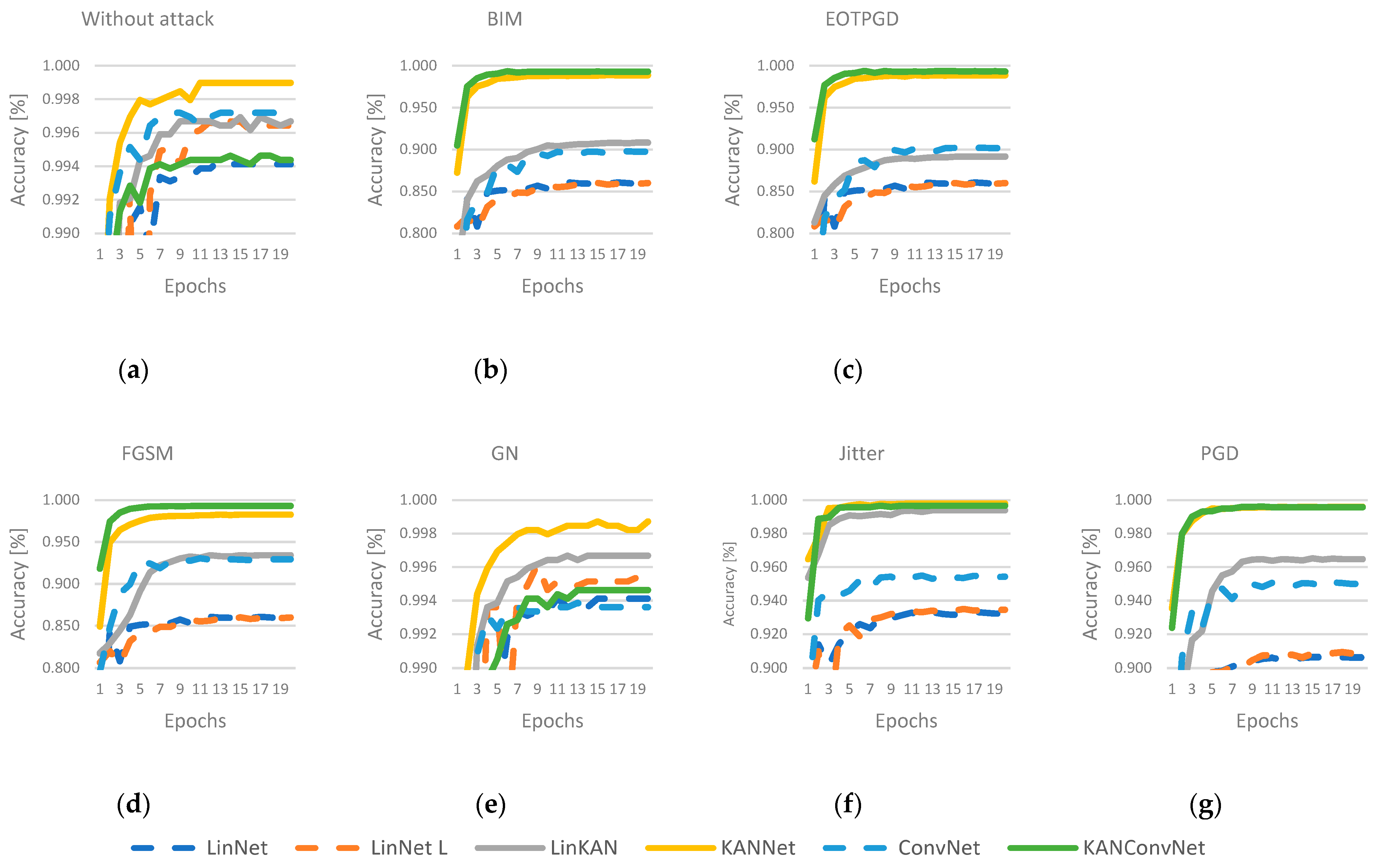Efficiency Analysis of Kolmogorov-Arnold Networks for Visual Data Processing †
Abstract
1. Introduction
2. Kolmogorov–Arnold Network Theory
3. Proposed Dataset
4. Network Architectures
5. Results
6. Conclusions
Funding
Institutional Review Board Statement
Informed Consent Statement
Data Availability Statement
Conflicts of Interest
References
- Liu, Z.; Wang, Y.; Vaidya, S.; Ruehle, F.; Halverson, J.; Soljačić, M.; Hou, T.Y.; Tegmark, M. KAN. Kolmogorov-Arnold Networks. arXiv 2024, arXiv:2404.19756. [Google Scholar]
- Kolmogorov, A.N. On the Representation of Continuous Functions of Several Variables as Superpositions of Continuous Functions of One Variable and Addition. Dokl. Akad. Nauk SSSR 1957, 114, 953–956. [Google Scholar]
- Schmidt-Hieber, J. The Kolmogorov-Arnold Representation Theorem Revisited. arXiv 2020, arXiv:2007.15884v2. [Google Scholar] [CrossRef] [PubMed]
- Rawat, W.; Wang, Z. Deep Convolutional Neural Networks for Image Classification: A Comprehensive Review. Neural Comput. 2017, 29, 2352–2449. [Google Scholar] [CrossRef] [PubMed]
- Garcia-Garcia, A.; Orts-Escolano, S.; Oprea, S.; Villena-Martinez, V.; Martinez-Gonzalez, P.; Garcia-Rodriguez, J. A Survey on Deep Learning Techniques for Image and Video Semantic Segmentation. Appl. Soft Comput. 2018, 70, 41–65. [Google Scholar] [CrossRef]
- Zhao, Z.Q.; Zheng, P.; Xu, S.; Wu, X. Object Detection with Deep Learning: A Review. arXiv 2019, arXiv:1807.05511. [Google Scholar] [CrossRef] [PubMed]
- Sze, V.; Chen, Y.H.; Yang, T.J.; Emer, J. Efficient Processing of Deep Neural Networks: A Tutorial and Survey. arXiv 2017, arXiv:1703.09039. [Google Scholar] [CrossRef]
- Deng, L.; Li, G.; Han, S.; Shi, L.; Xie, Y. Model Compression and Hardware Acceleration for Neural Networks: A Comprehensive Survey. Proc. IEEE 2020, 108, 485–532. [Google Scholar] [CrossRef]
- Vaishnav, M.; Cadene, R.; Alamia, A.; Linsley, D.; VanRullen, R.; Serre, T. Understanding the Computational Demands Underlying Visual Reasoning. Neural Comput. 2022, 34, 1075–1099. [Google Scholar] [CrossRef] [PubMed]
- Hendrycks, D.; Gimpel, K. Gaussian Error Linear Units (GELUs). arXiv 2016, arXiv:1606.08415v5. [Google Scholar]
- Agarap, A.F. Deep Learning Using Rectified Linear Units (ReLU). arXiv 2018, arXiv:1803.08375v2. [Google Scholar]
- Kurakin, A.; Goodfellow, I.; Bengio, S. Adversarial Examples in the Physical World. arXiv 2017, arXiv:1607.02533. [Google Scholar]
- Zimmermann, R.S. Comment on “Adv-BNN: Improved Adversarial Defense through Robust Bayesian Neural Network”. arXiv 2019, arXiv:1907.00895. [Google Scholar]
- Goodfellow, I.J.; Shlens, J.; Szegedy, C. Explaining and Harnessing Adversarial Examples. arXiv 2015, arXiv:1412.6572. [Google Scholar]
- Schwinn, L.; Raab, R.; Nguyen, A.; Zanca, D.; Eskofier, B. Exploring Misclassifications of Robust Neural Networks to Enhance Adversarial Attacks. arXiv 2021, arXiv:2105.10304. [Google Scholar] [CrossRef]
- Madry, A.; Makelov, A.; Schmidt, L.; Tsipras, D.; Vladu, A. Towards Deep Learning Models Resistant to Adversarial Attacks. arXiv 2019, arXiv:1706.06083. [Google Scholar]
- Kim, H. Torchattacks: A PyTorch Repository for Adversarial Attacks. arXiv 2021, arXiv:2010.01950. [Google Scholar]
- Kingma, D.P.; Ba, J. Adam: A Method for Stochastic Optimization. arXiv 2014, arXiv:1412.6980v9. [Google Scholar]




Disclaimer/Publisher’s Note: The statements, opinions and data contained in all publications are solely those of the individual author(s) and contributor(s) and not of MDPI and/or the editor(s). MDPI and/or the editor(s) disclaim responsibility for any injury to people or property resulting from any ideas, methods, instructions or products referred to in the content. |
© 2024 by the author. Licensee MDPI, Basel, Switzerland. This article is an open access article distributed under the terms and conditions of the Creative Commons Attribution (CC BY) license (https://creativecommons.org/licenses/by/4.0/).
Share and Cite
Hollósi, J. Efficiency Analysis of Kolmogorov-Arnold Networks for Visual Data Processing. Eng. Proc. 2024, 79, 68. https://doi.org/10.3390/engproc2024079068
Hollósi J. Efficiency Analysis of Kolmogorov-Arnold Networks for Visual Data Processing. Engineering Proceedings. 2024; 79(1):68. https://doi.org/10.3390/engproc2024079068
Chicago/Turabian StyleHollósi, János. 2024. "Efficiency Analysis of Kolmogorov-Arnold Networks for Visual Data Processing" Engineering Proceedings 79, no. 1: 68. https://doi.org/10.3390/engproc2024079068
APA StyleHollósi, J. (2024). Efficiency Analysis of Kolmogorov-Arnold Networks for Visual Data Processing. Engineering Proceedings, 79(1), 68. https://doi.org/10.3390/engproc2024079068




